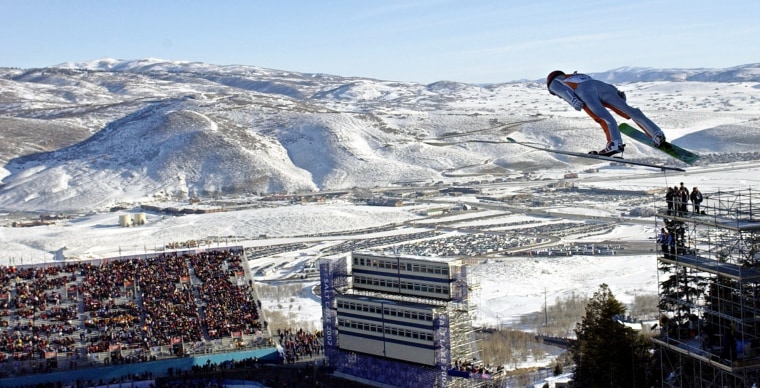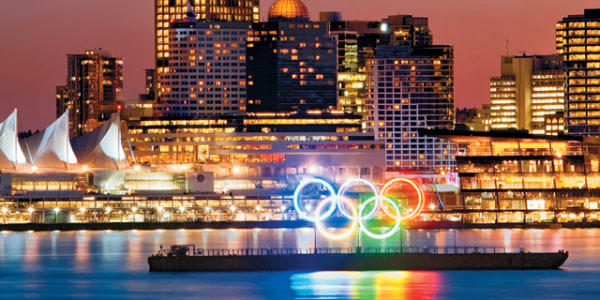In addition to great powder snow and a long winter, Utah's ski industry is blessed by the lingering buzz of the 2002 Winter Olympics, plus a major nearby airport that makes getting to Salt Lake City easy from other parts of the country.
The Olympics brought international acclaim, dozens of new and faster lifts and thousands of more acres of skiable terrain. Traffic on the slopes was up by 37 percent in the six years after the Olympics, before the economy soured, making Utah skiing a $1 billion industry.
"That was our coming-out party," said Nathan Rafferty, president of the trade group Ski Utah. "We were always in the shadows of other resorts, like Colorado's. But hosting the Olympics put us on the map."
The most noticeable Olympic legacy has been nonstop development, most recently at Solitude Mountain Resort, which just added its fourth new chair lift since the 2002 Games.
Another legacy, say local skiers: It's getting crowded on the slopes. Forget trying to ski Saturdays at the most popular resorts, they say. The lift lines at Alta ski area, for one, are getting longer with waiting skiers more impatient.
Off the slopes, this season's biggest improvement is a new set of state liquor laws. The reforms broke up a private club system that made getting inside a bar without a membership a hassle. Utah still strictly regulates drinking venues, a quota system limits their numbers, and regular strength draft beer is banned, thanks to the influence of the teetotalling Mormon church.
But lawmakers are starting to ease up, in part to make the state a more attractive destination.
From the outset, no Utah resort built itself up bigger or faster than Snowbasin, the downhill Olympic venue near Ogden that dropped $200 million on a makeover with stately day lodges and high-speed chair lifts, gondolas and a tram. Snowbasin, still without any base lodging, rarely sees a crowded lift line.
The Canyons, a rival in development that was once the smallest Park City resort, now bills itself Utah's largest ski area. That claim might properly go to Vail-sized Powder Mountain, still something of a Utah secret, but skiers there have to climb, shuffle along mountain ridges or get pulled by a snowcat to reach much of the terrain.
Powder Mountain, with 5,500 acres, is hidden in the mountains 19 miles northeast of Ogden.
Utah offers a variety of resorts all within an hour's drive of the airport. Many rub shoulders near Salt Lake at higher elevations of the 11,000-foot Wasatch Range. There's renewed talk of linking them up, making for North America's largest skiing complex.
For now, Utah's resorts are happy to bask in Olympic glow.
"It's fair to say all of the resorts have benefited to varying degrees from the Olympic recognition," said Mike Goar, managing director of The Canyons, which sprawls across eight peaks and 3,500 acres. "It really did shine a bright light on Utah. This is a terrific location because of easy access and consistent snow."
Truth be told, Utah always had the best snow, a secret the Olympics spilled far and wide. Major skiing magazines started to consistently rate Utah's resorts the best.
For a third straight year, Deer Valley Resort has been named the No. 1 North American ski resort by a leading magazine, Skiing.
Deer Valley gets high marks mostly for service. For snow alone, Alta-Snowbird ranked No. 1, as it almost always does in major surveys.
More than 500 inches of snow blanket Utah's northern mountains from October through May. Thanks to the combined effects of the desert and Great Salt Lake, winter storms dispersing dry, powdery snow can linger for days over Wasatch resorts. From the northwest, the storms funnel into Salt Lake City's Cottonwood Canyons, dropping their loads on four resorts that log the biggest season totals.
For a religious state, the snow here is almost holy.
"You blow it off your hand, it's like smoke," said Bill Tatton, a 47-year-old financial consultant now attending helicopter flight school. "We have the best snow on this rock (planet,) especially when the Great Salt Lake turns it on. I've skied days when you needed a snorkel to breathe, it's so deep and light."
Not one to miss a good day of skiing, Tatton was trudging up Alta in a foot of fresh snow one October day before the lifts started operating. He grew up skiing in Colorado, then spent time at California's Mammoth Mountain Ski Area, but his first time in Utah, he said, was like nothing else.
It's like falling on pillows of dry feathers.
"The snow also smells differently — a salty aroma," said Rick Yost, a 57-year-old locomotive engineer for Union-Pacific Railroad. "It was in my face a lot when I learned to powder ski."
Utah's ski industry rivals Lake Tahoe's, a mountainous region straddling California and Nevada that also receives a bounty of snowfall. In many ways, the two Olympic regions progressed similarly on bragging rights.
The 1960 Winter Games were held at Squaw Valley, a sprawling ski area with 33 ski lifts. One lift is by reputation North America's best for transporting skiers quickly to the resort's best terrain. Together, the lifts move more people uphill faster than anywhere in North America.
"It put Tahoe on the map," said John Wagnon, president of the trade group Ski Lake Tahoe. "It was early in Winter Olympic history, before the grand fanfare it has now."
It was the first televised Winter Games, "so people all over the world saw California skiing," Squaw Valley spokeswoman Savannah Cowley said. "It gave us an international name."
Slideshow 25 photos
Vancouver, B.C., 2010
Skiing around Lake Tahoe was at its infancy. Now major resorts around Lake Tahoe log up to 3.5 million skier visits a season. Utah recorded 3.9 million last winter, down from 4.2 million the year before.
Utah has 13 to Lake Tahoe's 14 resorts, but half a dozen of Tahoe's ski areas are much smaller than most of Utah's.
Stewart Katz, for one, moved to Lake Tahoe to beat the Utah crowds and its desert heat in summer. Summers at Lake Tahoe are much cooler.
"It's also a lot cheaper for locals out here," said Stewart, a retired South Carolina pawnshop businessman who snapped up season passes at Heavenly and Kirkwood resorts for $329 and $259.
But Katz admits the bounty of dry Utah snow can't be beat.
At Alta last spring, he recalls, "we had a foot a day for 14 days in April. You couldn't even breathe."
One of those days, "I came off the mountain choking."

